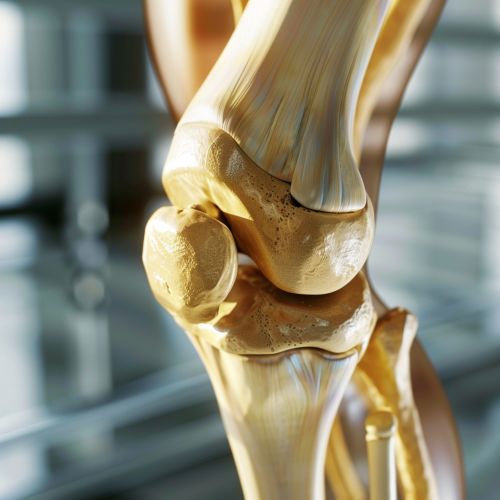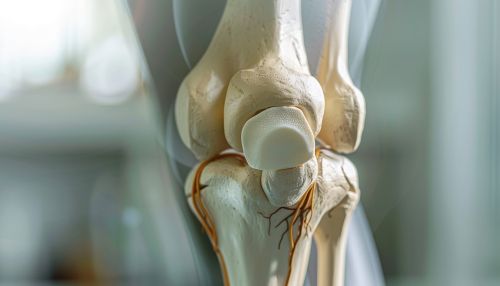Human Joints: Difference between revisions
(Created page with "== Anatomy of Human Joints == Human joints, also known as articulations, are the points where two or more bones meet. They are responsible for movement and provide mechanical support to the body. There are various types of joints in the human body, classified according to their structure and function. <div class='only_on_desktop image-preview'><div class='image-preview-loader'></div></div><div class='only_on_mobile image-preview'><div class='...") |
No edit summary |
||
| (One intermediate revision by the same user not shown) | |||
| Line 3: | Line 3: | ||
Human joints, also known as [[Articulation (anatomy)|articulations]], are the points where two or more bones meet. They are responsible for movement and provide mechanical support to the body. There are various types of joints in the human body, classified according to their structure and function. | Human joints, also known as [[Articulation (anatomy)|articulations]], are the points where two or more bones meet. They are responsible for movement and provide mechanical support to the body. There are various types of joints in the human body, classified according to their structure and function. | ||
[[Image:Detail-77845.jpg|thumb|center|Close-up image of a human knee joint showing the bones, cartilage, and ligaments.|class=only_on_mobile]] | |||
[[Image:Detail-77846.jpg|thumb|center|Close-up image of a human knee joint showing the bones, cartilage, and ligaments.|class=only_on_desktop]] | |||
=== Structural Classification === | === Structural Classification === | ||
Latest revision as of 00:36, 8 May 2024
Anatomy of Human Joints
Human joints, also known as articulations, are the points where two or more bones meet. They are responsible for movement and provide mechanical support to the body. There are various types of joints in the human body, classified according to their structure and function.


Structural Classification
Structurally, joints are classified into three types: fibrous, cartilaginous, and synovial.
Fibrous Joints
Fibrous joints are immovable (synarthrosis) or slightly movable (amphiarthrosis) joints where the bones are connected by fibrous tissue. Examples include the sutures of the skull and the syndesmosis joint between the tibia and fibula.
Cartilaginous Joints
Cartilaginous joints are also immovable or slightly movable joints. In these joints, the bones are connected by cartilage. Examples include the pubic symphysis and the intervertebral discs in the spine.
Synovial Joints
Synovial joints are freely movable (diarthrosis) joints. They have a unique structure that includes a joint cavity filled with synovial fluid. Examples include the knee, elbow, and shoulder joints.
Functional Classification
Functionally, joints are classified into three types: synarthrosis (immovable), amphiarthrosis (slightly movable), and diarthrosis (freely movable).
Synarthrosis
Synarthrosis joints are immovable joints. They are designed for strength and stability. Examples include the sutures of the skull.
Amphiarthrosis
Amphiarthrosis joints are slightly movable joints. They provide both stability and mobility. Examples include the intervertebral discs of the spine.
Diarthrosis
Diarthrosis joints, also known as synovial joints, are freely movable joints. They provide a wide range of movement. Examples include the knee, elbow, and shoulder joints.
Joint Components
The main components of a joint include bones, ligaments, tendons, muscles, and the joint capsule. The joint capsule is further divided into the synovial membrane and the fibrous capsule.
Bones
Bones form the framework of the body and contribute to the shape, alignment, and positioning of body parts. They also protect some body organs, and are involved in muscular action and body movements.
Ligaments
Ligaments are fibrous tissues that connect bones to other bones. They provide stability to the joint by limiting the amount of movement possible.
Tendons
Tendons are fibrous tissues that connect muscles to bones. They transmit the force generated by the muscle to the bone, causing movement.
Muscles
Muscles are tissues that contract to produce movement. They are attached to bones by tendons.
Joint Capsule
The joint capsule is a fibrous sac that encloses the joint cavity. It is lined with a synovial membrane that produces synovial fluid for lubrication.
Joint Disorders
There are many disorders that can affect human joints. These include osteoarthritis, rheumatoid arthritis, bursitis, gout, strains, sprains, and other injuries. These disorders can cause pain, stiffness, and other symptoms.
